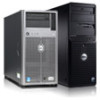Dell PowerEdge M520 Brocade M5424 Blade Server SAN I/O Module Hardware Referen - Page 19
Configuring the SAN I/O Module, Items required
 |
View all Dell PowerEdge M520 manuals
Add to My Manuals
Save this manual to your list of manuals |
Page 19 highlights
Chapter Configuring the SAN I/O Module 2 Use procedures in this chapter to configure the SAN I/O Module to operate on a network and fabric. Also use steps to change the Module's operating mode (Fabric OS Native and Access Gateway modes), activate Ports on Demand (POD), and connect to the SAN I/O Module using Web Tools. NOTE Although the SAN I/O Module is configured at the factory for Fabric OS Native mode, you can enable it for Access Gateway mode. For more information, refer to "Fabric OS Native and Access Gateway modes" on page 1. This chapter provides configuration procedures that use SAN I/O Module Command Line Interface (CLI) and the Web Tools application. For details refer to the Web Tools Administrator's Guide, Access Gateway Administrator's Guide, and Fabric OS Command Reference Manual. If the same operation can be performed using the Blade Server Enclosure's Chassis Management Controller (CMC) application, use that application instead. Items required The following items are required for configuring and connecting the SAN I/O Module for use in a network and fabric: • The SAN I/O Module installed in a Blade Server Enclosure. For instructions, refer to the steps on installing an I/O module in the Hardware Owner's Manual for the Blade Server Enclosure. • If required, management workstation (computer) that has a terminal emulator (such as HyperTerminal) or a keyboard, video, and mouse (KVM) device. Note that this is only required if not changing the SAN I/O Module IP address through the Blade Server Enclosure GUI or CLI management programs. • An unused IP address and corresponding subnet mask and gateway address unless DHCP is used. • If required, a serial cable to connect to the SAN I/O Module serial console port. Note that this is only required if not changing the SAN I/O Module IP address through the Blade Server Enclosure GUI or CLI management programs. • SFP transceivers and compatible fibre cables, as required. • Access to an FTP server for backing up the SAN I/O Module configuration. • Access to these publications: • Blade Server Enclosure Hardware Owner's Manual • Blade Server Enclosure Configuration Guide • Fabric OS Command Reference Manual • SAN TECH NOTE - Preparing to Install the Brocade Access Gateway • Access Gateway Administrator's Guide • Web Tools Administrator's Guide M5424 SAN I/O Module Hardware Reference Manual 9 53-1001082-01















